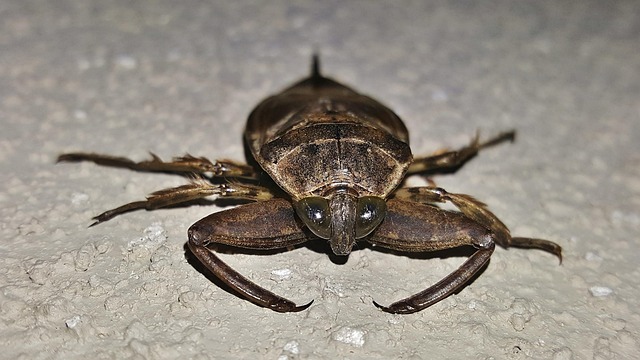Understanding seasonal patterns of pillbugs – peak activity in spring and fall, population decline in warmer months, and potential dormancy or migration indoors during winter – is crucial for effective management. Eco-friendly pillbug solutions include strategic sanitation, beneficial insects, natural repellents like diatomaceous earth or neem oil, and planting bug-repelling plants. Homeowners can proactively prepare by inspecting and sealing entry points, regular cleaning, maintaining a clean lawn, planting lavender or marigolds, and using safe, natural pest control methods. These strategies enable sustainable protection from pillbugs.
In the ever-changing seasons, pillbugs exhibit distinct activity patterns, peaking during moist spring and autumn months. Understanding these seasonal trends is crucial for effective prevention and control of infestations. This article explores eco-friendly methods and organic solutions to combat pillbugs, focusing on natural repellents and proactive preparation tips for homeowners. By adopting green approaches, you can minimize the use of harsh chemicals while enjoying a pest-free environment.
Understanding Seasonal Pillbug Patterns: When and Where to Expect Activity Peaks
Understanding seasonal patterns is key to knowing when and where to expect pillbug activity peaks. These tiny insects, often considered pests, exhibit distinct behaviors throughout the year, influenced by environmental factors such as temperature, moisture, and food availability. In general, pillbugs thrive in cool, moist environments, making spring and fall the primary seasons for heightened activity. During these periods, you’ll likely observe them congregating in areas with high organic matter content, like mulch, compost piles, or leaf litter.
As temperatures rise in summer, pillbug populations tend to decline, seeking refuge in cooler, more shaded spots. Conversely, if winter brings prolonged cold snaps and dryness, they may become dormant or seek indoor habitats. Being aware of these seasonal trends is crucial for implementing effective eco-friendly pillbug solutions. By understanding their preferred habitats and behaviors at different times of the year, you can develop strategic prevention and control measures tailored to each season.
Eco-Friendly Methods to Prevent and Control Pillbug Infestations
In the quest to control pillbugs, opting for eco-friendly methods is a smart and sustainable choice. Traditional chemical pesticides can be harmful to both the environment and non-target organisms, including beneficial insects. Instead, homeowners can employ several natural strategies to prevent and manage pillbug infestations. One effective approach is maintaining excellent sanitation practices, especially in areas prone to moisture accumulation. Pillbugs thrive in damp environments, so keeping outdoor spaces well-drained and dry can significantly deter them. Regularly cleaning up organic debris, leaves, and grass clippings reduces hiding spots and food sources for these pests.
Another eco-friendly solution involves the strategic use of beneficial insects, such as ladybugs and lacewings, which are natural predators of pillbugs. Introducing these insects into affected areas can help control populations naturally. Additionally, sealing entry points and cracks in walls, foundations, and doors prevents pillbugs from finding their way inside. Natural repellents like diatomaceous earth or neem oil can also be applied around potential entry points to discourage pillbug activity without causing harm to the environment or pets.
Organic Repellents and Natural Solutions for a Green Approach
When it comes to dealing with pillbugs, many homeowners are seeking organic repellents and natural solutions as a preferred approach. This green method focuses on harnessing the power of nature to ward off these pesky critters without resorting to harsh chemicals. An eco-friendly pillbug solution can be as simple as maintaining excellent hygiene and sanitation practices around your home, particularly in areas where food is stored or prepared. Regularly cleaning surfaces with hot water and soap can help eliminate potential hiding spots and food sources for pillbugs.
Additionally, certain plants and essential oils are known to repel pillbugs naturally. For instance, lemongrass, mint, and lavender have strong scents that these insects find unappealing. Planting these herbs around your property or using essential oil-infused sprays can create a natural barrier against pillbug invasion. This approach not only keeps your home pillbug-free but also contributes to a healthier environment, free from synthetic chemicals.
Proactive Preparation Tips for Homeowners: A Step-by-Step Guide
Proactive Preparation Tips for Homeowners: A Step-by-Step Guide
As seasonal trends dictate, pillbugs are more active during spring and fall when temperatures cool down. To prepare for these invasions, homeowners should adopt a proactive approach focusing on prevention and eco-friendly solutions. Start by inspecting your home for any gaps or cracks that might serve as entry points. Seal these openings with caulk to create a barrier against pillbugs and other pests. Regularly clean and vacuum your home, paying special attention to corners and crevices where pillbugs tend to hide. Empty vacuum bags promptly to avoid attracting more bugs.
Next, maintain a clean lawn and garden to deprive pillbugs of food sources. Remove dead leaves, grass clippings, and compost piles nearby your property. Consider planting eco-friendly plants that naturally repel pillbugs, such as lavender, mint, or marigolds. Lastly, implement natural pest control methods like diatomaceous earth or neem oil, which are safe for both people and pets. By following these steps, homeowners can effectively prepare their homes against seasonal pillbug activity while opting for sustainable, eco-friendly solutions.
Pillbugs, though persistent, can be effectively managed with a strategic approach that considers their seasonal trends. By understanding when and where these creatures are most active, homeowners can implement eco-friendly methods and organic solutions to prevent and control infestations. Following the step-by-step preparation tips outlined in this article ensures a proactive and sustainable approach to dealing with pillbugs, promoting a harmonious coexistence between humans and nature. Adopting these green practices not only protects your home but also contributes to a healthier environment, making it a win-win for everyone.
